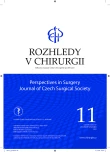Dunbar syndrome – single-center experience with surgical treatment
Authors:
T. Grus 1; T. Klika 1; G. Grusová 2; J. Lindner 1; L. Lambert 3
Authors‘ workplace:
II. chirurgická klinika kardiovaskulární chirurgie Všeobecné fakultní nemocnice a 1. lékařské fakulty Univerzity Karlovy, Praha
1; V. interní klinika – klinika gastroenterologie a hepatologie Všeobecné fakultní nemocnice a 1. lékařské fakulty Univerzity Karlovy, Praha
2; Radiodiagnostická klinika Všeobecné fakultní nemocnice a 1. lékařské fakulty Univerzity Karlovy, Praha
3
Published in:
Rozhl. Chir., 2018, roč. 97, č. 11, s. 514-517.
Category:
Original articles
Overview
Introduction:
Dunbar syndrome is caused by compression of the truncus coeliacus (TC), most commonly by the median arcuate ligament. Chronic irritation of the TC during breathing leads to fibrous changes of the arterial wall and formation of fixed stenosis. This compression syndrome is often associated with specific complaints including weight loss and early postprandial epigastric pain. In this study, we summarize our experience with a group of 14 patients from a single institution.
Methods:
In 14 patients who were diagnosed with Dunbar syndrome and who were referred for surgery, we performed an invasive measurement of systemic pressure in a. radialis during the operation and compared it with invasively measured pressure in a. gastrica sinistra before and after the release of TC. In patients with significant stenosis (pressure gradient above 15 mmHg), a bypass was performed.
Results:
The initial pressure gradient of 56±19 mmHg decreased after the release of TC to 39±16 mmHg (p<0.0001). In 13 (93%) patients with a persisting elevated gradient (above 15 mmHg) this decreased by 5±3 (p<0.0001) after subsequent bypass surgery. All patients experienced a clinical improvement, and one year after the operation their symptoms disappeared altogether. During the follow-up, we did not record any complications or the need to perform an additional procedure.
Conclusion:
Surgical treatment of Dunbar syndrome is a safe modality with satisfactory long-term results. We believe that it is always convenient to assess how successful the release of TC was and, in the case of a significant residual stenosis, to consider further steps – in our case bypassing the stenotic segment.
Key words:
Dunbar syndrome − truncus coeliacus − median arcuate ligament – bypass
Sources
1. Ikeda O, Tamura Y, Nakasone Y, et al. Celiac artery stenosis/occlusion treated by interventional radiology. Eur J Radiol 2009;71:369–77.
2. Kuruvilla A, Murtaza G, Cheema A, et al. Median arcuate ligament syndrome: It is not always gastritis. J Investig Med High Impact Case Rep 2017. Available from: https://doi.org/10.1177/2324709617728750.
3. Levin DC, Baltaxe HA. High incidence of celiac axis narrowing in asymptomatic individuals. Am J Roentgenol Radium Ther Nucl Med 1972;116:426–9.
4. Foertsch T, Koch A, Singer H, et al. Celiac trunk compression syndrome requiring surgery in 3 adolescent patients. J Pediatr Surg 2007;42:709–13.
5. Horton KM, Talamini MA, Fishman EK. Median arcuate ligament syndrome: evaluation with CT angiography. Radiographics 2005;25:1177–82.
6. Duran M, Simon F, Ertas N, et al. Open vascular treatment of median arcuate ligament syndrome. BMC Surg 2017;17:95.
7. Kim EN, Lamb K, Relles D, et al. Median arcuate ligament syndrome-review of this rare disease. JAMA Surg 2016;151:471–7.
8. Jimenez JC, Harlander-Locke M, Dutson EP. Open and laparoscopic treatment of median arcuate ligament syndrome. J Vasc Surg 2012;56:869–73.
9. Do MV, Smith TA, Bazan HA, et al. Laparoscopic versus robot-assisted surgery for median arcuate ligament syndrome. Surg Endosc 203;27:4060–6.
10. Grus T, Lambert L, Vidim T, et al. Intraoperative measurement of pressure gradient in median arcuate ligament syndrome as a rationale for radical surgical approach. Acta Chir Belg 2018;118:36–41
11. Gloviczki P, Duncan AA. Treatment of celiac artery compression syndrome: does it really exist? Perspect Vasc Surg Endovasc Ther 2007;19:259–63.
12. Dunbar JD, Molnar W, Beman FF, et al. Compression of the celiac trunk and abdominal angina. Am J Roentgenol 1965;95:731–44.
13. Park CM, Chung JW, Kim HB, et al. Celiac axis stenosis: incidence and etiologies in asymptomatic individuals. Korean J Radiol 2001;2:8–13.
14. Mensink PBF, van Petersen AS, Kolkman JJ, et al. Gastric exercise tonometry: the key investigation in patients with suspected celiac artery compression syndrome. J Vasc Surg 2006;44:277–281.
15. De’Ath HD, Wong S, Szentpali K, et al. The laparoscopic management of median arcuate ligament syndrome and its long-term outcomes. J Laparoendosc Adv Surg Tech A 2018. Available from: doi:10.1089/lap.2018.0204.
16. Matsumoto AH, Angle JF, Spinosa DJ, et al. Percutaneous transluminal angioplasty and stenting in the treatment of chronic mesenteric ischemia: results and longterm followup. J Am Coll Surg 2002;194:S22−S31.
17. Reilly LM, Ammar AD, Stoney RJ, et al. Late results following operative repair for celiac artery compression syndrome. J Vasc Surg 1985;2:79–91.
18. Takach TJ, Livesay JJ, Reul GJ, et al. Celiac compression syndrome: tailored therapy based on intraoperative findings. J Am Coll Surg 1996;183:606–10.
19. Chivot C, Rebibo L, Robert B, et al. Ruptured pancreaticoduodenal artery aneurysms associated with celiac stenosis caused by the median arcuate ligament: A poorly known etiology of acute abdominal pain. Eur J Vasc Endovasc Surg 2016;51:295–301.
Labels
Surgery Orthopaedics Trauma surgeryArticle was published in
Perspectives in Surgery

2018 Issue 11
Most read in this issue
- Dunbar syndrome – single-center experience with surgical treatment
- Hypogastric artery aneurysm – a case report
- Trauma of the extracranial cerebral arteries due to injuries of the cervical spine
- Indications to open surgical revascularization of visceral arteries in the endovascular era
